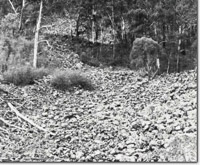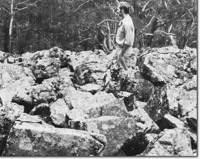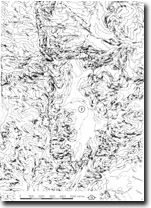8223-2 Howitt High Plains
|
This information has been developed from the publications:
|
Location: | 725810. Three kilometres north-east of Mt Howitt. |  Howitt High Plains. block stream of Older Basalts. |
Abstract: | High plains formed on Tertiary Older Volcanics, basalt block streams and pre-volcanic sediments. | |
Access: | Howitt Road. | |
Ownership: | Crown land. | |
Geology: | The Lower Carboniferous sediments of the Snowy Plains Formation are capped by non-vesicular basalt of Lower Tertiary age. Pre-volcanic sediments are exposed in a road cutting (700820). These consist of interbedded sandstones and clays. | |
Geomorphology: | The Howitt High Plains are situated at an altitude of between 1500 and 1600 m. It is generally flat-lying, a reflection of the basalt capping which appears to have blanketed a relatively level bedrock surface. The margins of the plain are defined by an abrupt break of slope. The steep western slopes are characterised by several large periglacial block streams which are composed of angular basalt boulders up to three m in diameter. The block streams are generally concave in long profile and several exhibit minor internal forms. For example, channels and shallow conical pits. The boulders are largely covered in lichen, suggesting that block streams are a relict feature. Periglacial processes have been invoked to account for the formation of these features which developed during glacial phases in the Pleistocene. | |
Significance: | State. The Howitt Plain is a representative example of the several areas of basalt-capped high plains occurring in the alpine region of Eastern Victoria. The basalt are of additional importance as they provide a suitable source rock for the formation of block streams. These latter forms are relict features and are indicative of the periglacial rather than glacial regimes which characterized the high country of Victoria during global glacial stages. | |
Management: | The block streams were formed by processes which are no longer active in the area. The preservation of these features in their entirety is therefore recommended. The basalt plain is of a size which would not be seriously degraded by localised disturbance. | |
References: | Neilson, J.L. 1962. 'Notes on the geology of the high plains of Victoria', Proc. R. Soc. Vict., 75 :227-284. | |
 Howitt High Plains. Detail of block stream boulders. |



